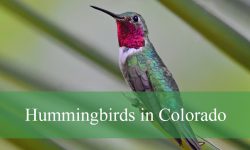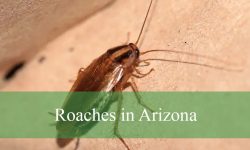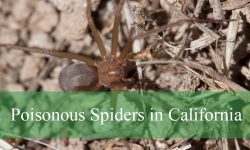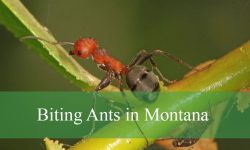Alabama is a paradise for hummingbird enthusiasts, offering the chance to observe these dazzling creatures in gardens, forests, and meadows across the state. The Ruby-throated Hummingbird dominates the summer skies, while rare visitors like Rufous and Buff-bellied Hummingbirds appear in cooler months. Each one adds vibrant color and energy to Alabama’s natural scenery.
As seasons shift, their swift movements and shimmering feathers bring life to wildflowers and nectar feeders. Birdwatchers across the Gulf Coast eagerly anticipate their arrival each spring, marking the return of one of the South’s most beloved migrants. The diversity of species reflects Alabama’s mild climate and rich habitats that support year-round hummingbird activity.
Observing these tiny travelers reveals the wonder of migration and the importance of native plants in sustaining wildlife. This detailed guide presents 12 hummingbird species recorded in Alabama, including their identification, habits, and favorite environments for spotting them in action.
Types of Hummingbirds Found in Alabama
Ruby-throated Hummingbird (Archilochus colubris)
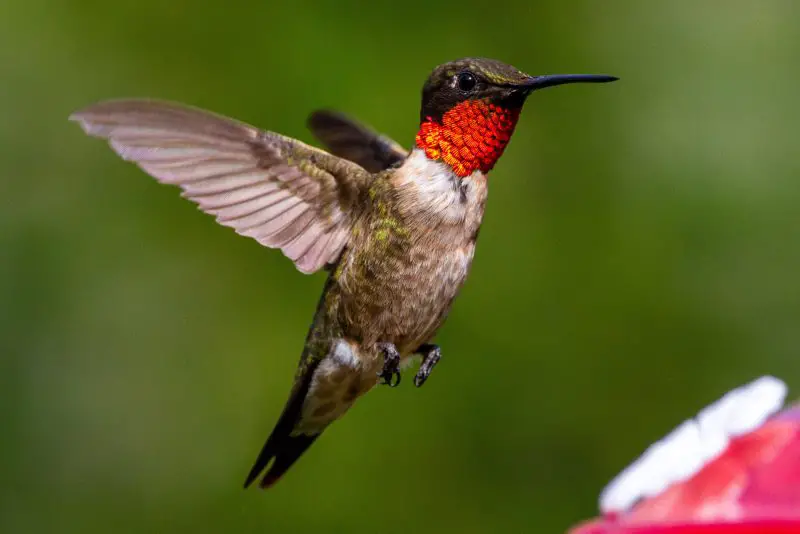
The Ruby-throated Hummingbird is the only hummingbird species that breeds regularly in Alabama. Males are easily recognized by their vivid ruby-red throats, which glisten like jewels under sunlight, and their metallic green backs. Females lack the red throat but share the same shimmering green plumage, making them equally captivating. Both sexes have slender bodies and long, slightly curved bills ideal for feeding on tubular flowers.
Measuring about 3 to 3.5 inches in length, this tiny bird weighs only 2 to 6 grams—lighter than a penny. Despite its size, it can flap its wings up to 50 times per second, producing a distinctive humming sound. During the breeding season, males perform dramatic U-shaped dives to impress females, showcasing their agility and speed.
In Alabama, these hummingbirds are most abundant from late March through September. They prefer habitats rich in flowering plants, including gardens, woodland edges, and meadows. They are especially attracted to red or orange blossoms such as trumpet creeper, coral honeysuckle, and bee balm. Homeowners often see them frequenting sugar-water feeders throughout the summer.
When autumn arrives, Ruby-throated Hummingbirds migrate to Central America, crossing the Gulf of Mexico in a single non-stop flight that can last up to 20 hours. Some individuals may linger into early winter, especially in southern parts of Alabama where the climate remains mild.
Black-chinned Hummingbird (Archilochus alexandri)
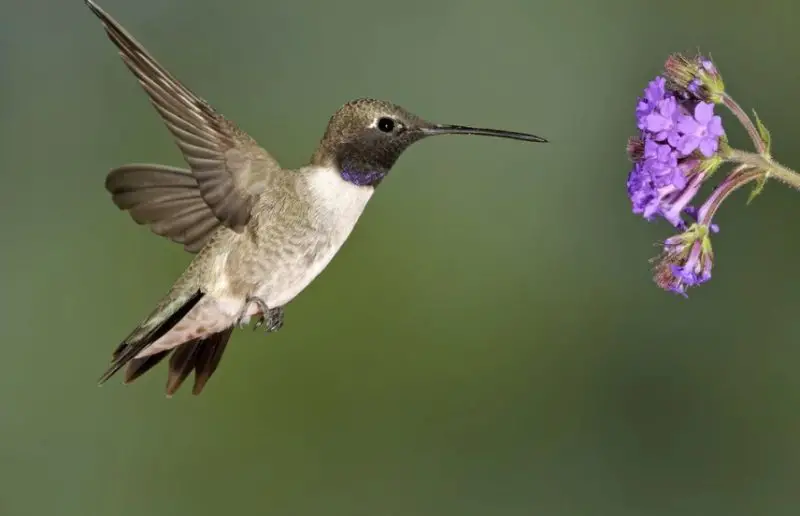
The Black-chinned Hummingbird is a rare but occasional visitor to Alabama, typically spotted during the winter months. Males display a striking black chin bordered by a narrow violet band that flashes in direct light, while females are more subdued with grayish-white underparts and green backs. Their plumage may look plain in comparison to other species, but their elegance lies in subtle iridescence and sleek form.
These hummingbirds measure around 3.25 inches in length, similar in size to the Ruby-throated Hummingbird. Their wings emit a faint hum, and their long, thin bills allow them to reach deep into flowers for nectar. They are quick and alert, often hovering motionless in midair before darting away with precision. Males are territorial, defending feeding areas from other hummingbirds with swift aerial chases.
In Alabama, sightings of the Black-chinned Hummingbird are more common along the Gulf Coast, particularly in Baldwin and Mobile Counties. They are drawn to suburban gardens with abundant nectar sources and hummingbird feeders, especially during mild winters. These adaptable birds can tolerate open woodlands, desert edges, and even urban yards if suitable food is available.
Though rare in the state, some individuals overwinter successfully, taking advantage of Alabama’s relatively warm climate and consistent food supply. Bird enthusiasts often report them during Christmas Bird Counts, highlighting the species’ slow eastward expansion from its traditional western range.
Rufous Hummingbird (Selasphorus rufus)
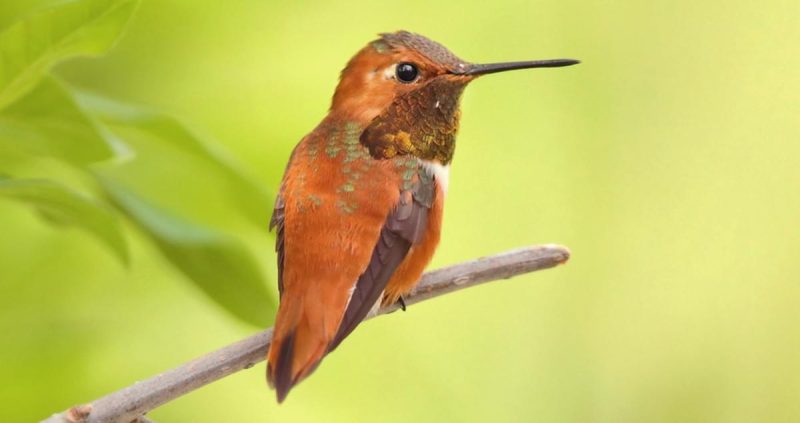
The Rufous Hummingbird is one of the most frequently reported winter hummingbirds in Alabama. Males are brilliant orange with iridescent red throats and white chests, while females have green backs with rust-colored flanks and tail feathers. Their fiery plumage and bold temperament make them unmistakable visitors to feeders during the colder months.
This species measures about 3.75 inches long, slightly larger than the Ruby-throated. It is renowned for its incredible endurance—capable of migrating over 2,000 miles from Alaska to Mexico each year. Despite its small stature, the Rufous Hummingbird is one of the most aggressive among its kind, fiercely defending its feeding territory from other birds, even those much larger in size.
In Alabama, Rufous Hummingbirds typically appear between October and March, favoring gardens, woodland edges, and rural backyards with reliable nectar feeders. They adapt well to human presence, often returning to the same wintering sites year after year. This behavior has helped ornithologists study their migration and site fidelity in the southeastern United States.
Because of Alabama’s mild winters and the availability of feeders, some Rufous Hummingbirds remain throughout the season before heading north in early spring. Their presence adds a flash of color to Alabama’s winter landscape, offering a rare chance for birdwatchers to witness this hardy traveler.
Calliope Hummingbird (Selasphorus calliope)
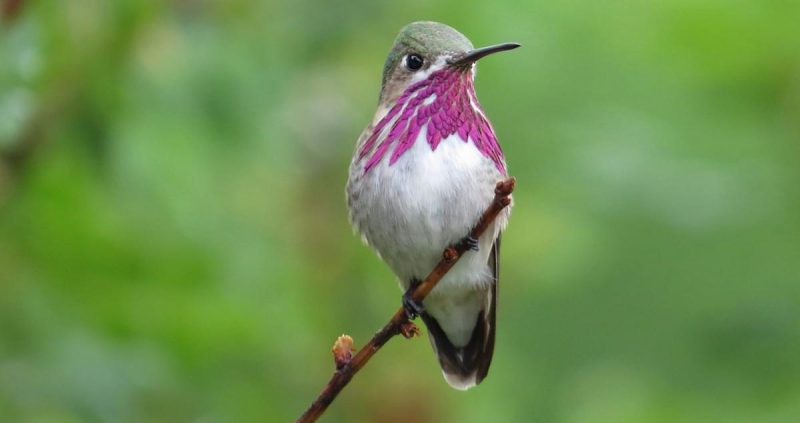
The Calliope Hummingbird holds the distinction of being the smallest bird in North America, measuring only about 3 inches in length and weighing less than 3 grams. Males have stunning magenta streaks radiating from their throats like tiny fireworks, contrasting with their green upperparts and white undersides. Females are less vivid but still elegant, with subtle buff-colored flanks and a greenish crown.
Though primarily a bird of the western United States, the Calliope Hummingbird occasionally ventures eastward, with a few individuals recorded in Alabama, usually in winter. These rare wanderers are most often found visiting hummingbird feeders, taking advantage of the state’s mild coastal temperatures. Observations are typically reported from November through February in southern Alabama.
The Calliope’s flight is remarkable for such a small creature—it beats its wings up to 60 times per second and can hover effortlessly as it sips nectar from flowers or feeders. Males are known for their distinctive diving display, where they emit a high-pitched sound produced by air rushing through their tail feathers.
In Alabama, sightings are considered special treats for birdwatchers, often confirmed by careful photography and banding studies. The presence of this tiny hummingbird demonstrates the increasing trend of western species appearing farther east during migration and winter months.
Allen’s Hummingbird (Selasphorus sasin)
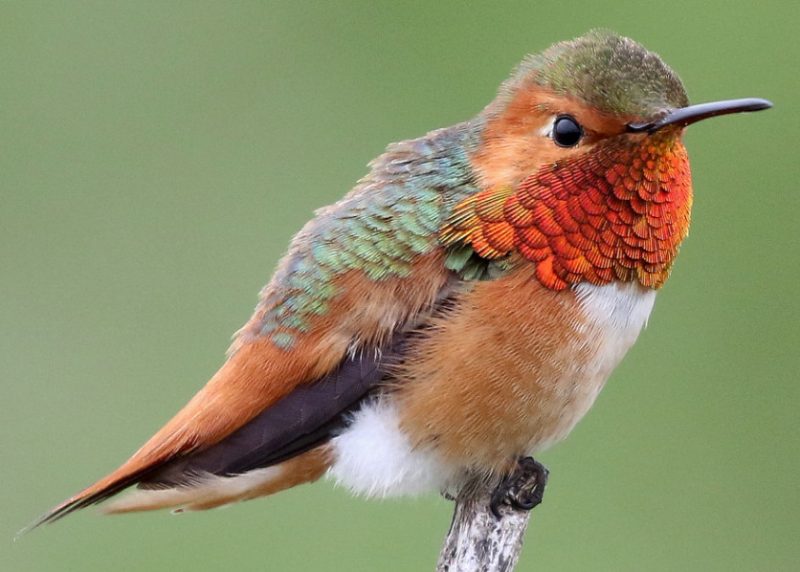
The Allen’s Hummingbird is an exceptionally rare visitor to Alabama, with most sightings occurring along the Gulf Coast during late fall and winter. Males are characterized by their bright orange backs and throats that shimmer with coppery-red iridescence, while females and immatures resemble Rufous Hummingbirds but have more green on their backs. Correct identification often requires close observation or expert review.
This species measures about 3.5 inches in length and exhibits quick, agile flight patterns. The wings beat around 50 times per second, producing a faint buzzing sound as they move between flowers. Males are territorial and perform impressive shuttle displays—darting side to side while flashing their iridescent throat to attract females.
Allen’s Hummingbirds breed along the Pacific Coast, primarily in California, but a few individuals wander eastward during migration. In Alabama, they are usually seen near feeders maintained year-round by dedicated hummingbird enthusiasts. These rare appearances often occur between November and February, especially after strong western wind patterns.
The species’ adaptability allows it to exploit Alabama’s gardens, wooded areas, and coastal habitats when nectar is available. Though sightings are few, each confirmed record contributes valuable data to ornithologists studying hummingbird vagrancy and migration beyond the species’ traditional range.
Anna’s Hummingbird (Calypte anna)
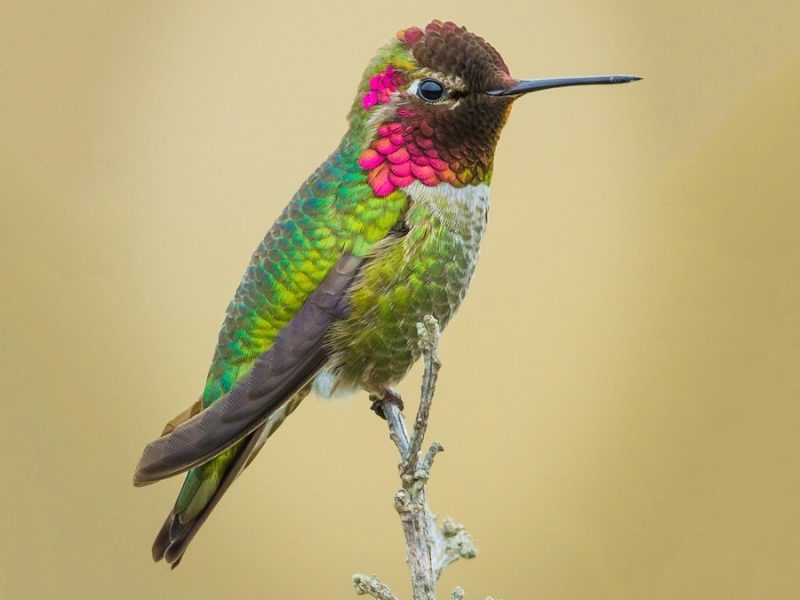
Anna’s Hummingbird is another rare but increasingly reported winter visitor in Alabama. Males are striking, adorned with a rose-pink crown and throat that gleam vividly under sunlight, while females have grayish underparts and green backs with a hint of pink on the throat. The combination of their size, color, and vocal behavior makes them one of the most charismatic hummingbirds seen in the region.
Measuring about 4 inches in length, Anna’s Hummingbird is slightly larger than most other species visiting Alabama. It produces a sharp, metallic “chip” call and can be surprisingly vocal during the winter months. Males perform elaborate courtship dives that include a dramatic swooping motion followed by a loud popping sound created by air through the tail feathers.
Though native to the Pacific Coast, this hummingbird has expanded its range eastward thanks to urban gardens and mild winters. In Alabama, sightings are most frequent in coastal and southern counties, where they take advantage of feeders and flowering plants. Some individuals overwinter successfully, feeding on both nectar and small insects.
Their adaptability to cooler temperatures and human-altered environments makes them one of the most likely western hummingbirds to continue establishing a foothold in the Southeast. Each winter, birdwatchers eagerly report new sightings, adding to the growing evidence of their expanding presence in Alabama.
Buff-bellied Hummingbird (Amazilia yucatanensis)
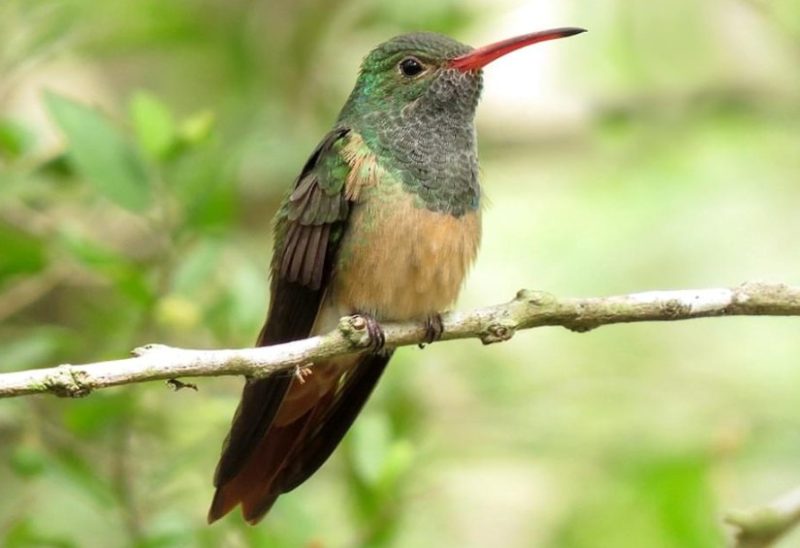
The Buff-bellied Hummingbird is a striking and uncommon visitor to Alabama, primarily recorded in the southern coastal regions during late fall and winter. It is larger than most eastern hummingbirds, measuring around 4.3 inches in length, and displays an elegant mix of shimmering emerald-green upperparts and a buffy or cinnamon-colored belly. Its tail is a distinctive rufous shade with a greenish gloss, and both sexes share a bright reddish bill tipped with black.
In good light, the Buff-bellied Hummingbird’s throat glows with an intense golden-green iridescence, giving it a vibrant, jewel-like appearance. This species is often mistaken for Anna’s or Broad-billed Hummingbirds but can be distinguished by its unique belly color and heavier build. It produces soft, high-pitched chirps while feeding and may chase away smaller hummingbirds from feeders or flowering patches.
Within Alabama, this species is occasionally seen in Baldwin and Mobile Counties, especially near coastal woodlands, gardens, and shrubby habitats. Its preferred environment includes areas rich in nectar plants such as coral honeysuckle, firebush, and shrimp plant. Observers also report it frequenting hummingbird feeders stocked with sugar water throughout the cooler months.
The Buff-bellied Hummingbird breeds in southern Texas and Mexico but expands its range northward during fall and winter. Its presence in Alabama underscores how Gulf Coast climates and backyard feeding stations are attracting a growing number of tropical species. Birders value every sighting as part of an ongoing shift in hummingbird migration patterns across the Southeast.
Broad-tailed Hummingbird (Selasphorus platycercus)
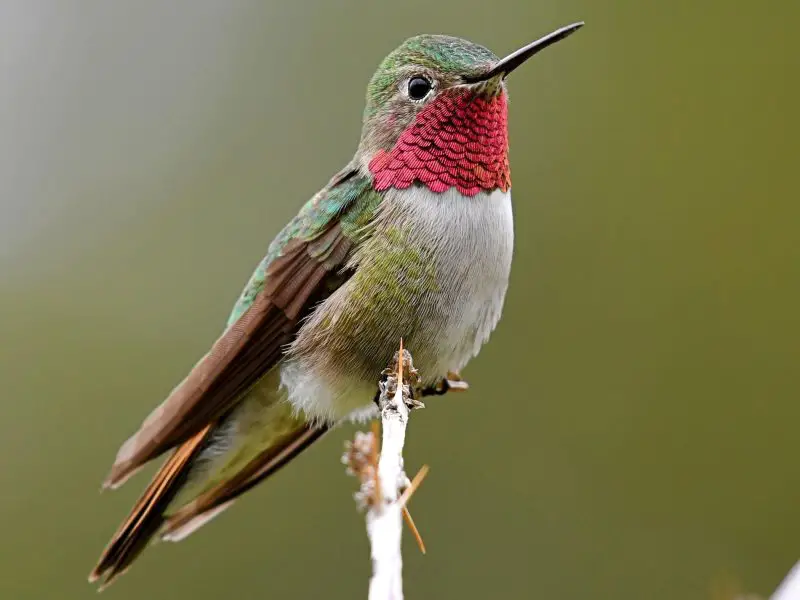
The Broad-tailed Hummingbird is a rare migrant in Alabama, known for its metallic trilling sound produced by its wing feathers during flight. Measuring about 4 inches in length, this species has a bright green back and a white chest. Adult males feature a dazzling rose-red throat that flashes brilliantly in sunlight, while females and immatures show greenish upperparts and buff-colored sides with speckled throats.
Its wing trill serves both as a territorial signal and a characteristic field mark, making it one of the easiest western hummingbirds to identify by sound. The Broad-tailed Hummingbird’s long wings and slender body give it graceful flight movements as it hovers and darts among blossoms. Like most hummingbirds, it relies heavily on nectar but also consumes small insects for protein.
Sightings in Alabama are extremely rare but have been confirmed along the Gulf Coast and occasionally inland. It prefers open woodlands, meadows, and gardens where nectar sources are abundant, often visiting feeders in late fall. Some individuals may linger into winter if conditions remain mild and food is available.
This species breeds primarily in the Rocky Mountains and southwestern United States, but its eastward appearances suggest occasional long-distance dispersal. Each documented record in Alabama offers valuable data for researchers tracking vagrant hummingbirds and the effects of weather patterns on their migration routes.
Broad-billed Hummingbird (Cynanthus latirostris)
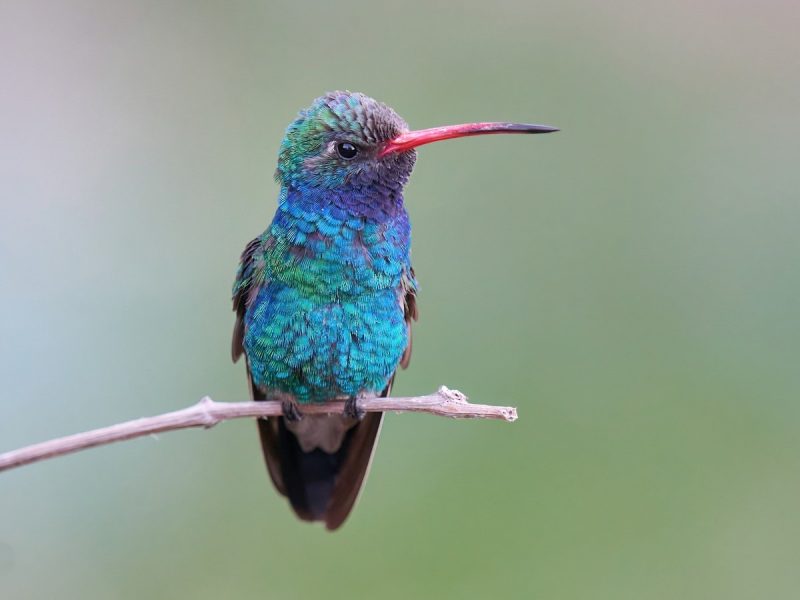
The Broad-billed Hummingbird is a rare but spectacular visitor to Alabama, instantly recognizable by its vivid blue-green plumage and bright red bill tipped in black. Males are particularly striking, with metallic turquoise throats that shimmer in sunlight, while females are paler with green upperparts and grayish underparts. Their medium size—about 3.75 inches long—combined with their colorful features makes them stand out even among other hummingbirds.
Native to the arid regions of the southwestern U.S. and Mexico, this species occasionally strays eastward, appearing along the Gulf Coast states, including southern Alabama. It thrives in areas with abundant flowering plants and is highly adaptable, often frequenting suburban gardens and feeders. When feeding, it hovers with incredible precision, inserting its long bill deep into tubular flowers like coral honeysuckle or salvia.
In Alabama, Broad-billed Hummingbirds are usually reported during late fall or winter, often after strong western wind systems. They are bold and curious, sometimes visiting feeders multiple times per day. Males perform elaborate display flights, arching and looping through the air to impress females or defend feeding spots.
These rare appearances excite birdwatchers, as the Broad-billed Hummingbird’s vivid coloration and rarity make every sighting memorable. Its growing list of southeastern records highlights how changes in climate and habitat availability may be expanding its occasional range into new territories.
Costa’s Hummingbird (Calypte costae)
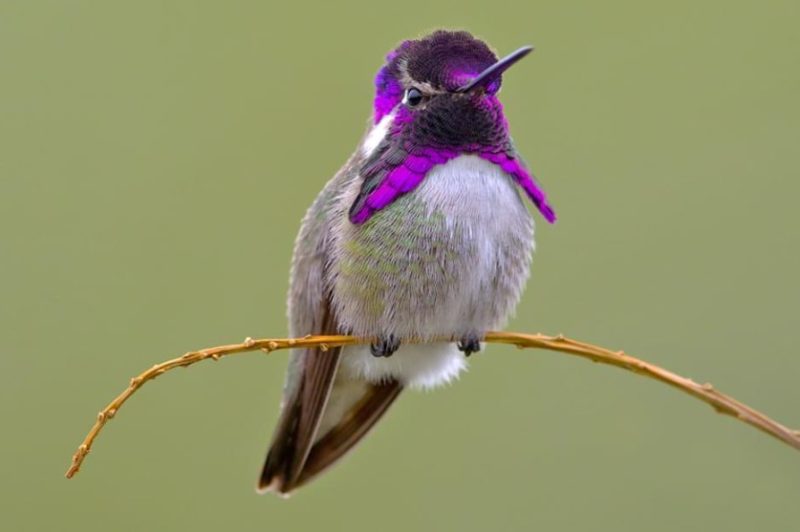
The Costa’s Hummingbird is an exceptionally rare visitor in Alabama, typically seen only a few times per decade. Native to the deserts of the southwestern United States and Baja California, this species is known for its compact body, short tail, and brilliant violet-purple crown and throat. The male’s iridescent plumage flares outward like a small cape, creating one of the most dazzling displays among North American hummingbirds.
Females and immatures are less vivid, showing greenish upperparts and grayish-white underparts. Measuring about 3.25 inches in length, Costa’s Hummingbird is among the smaller species likely to appear in Alabama. It produces a thin, high-pitched call and performs dramatic U-shaped courtship dives that glitter with flashes of violet as sunlight strikes its throat feathers.
Though it favors arid habitats in its native range, this species has occasionally been recorded in southern Alabama, particularly near well-maintained feeders. Birders sometimes spot them in winter, when wandering individuals drift eastward due to favorable winds or mild temperatures. Their adaptability to nectar feeders has allowed them to survive temporarily in unfamiliar environments.
Every Costa’s Hummingbird sighting in Alabama is carefully documented, as it provides valuable evidence of this species’ rare eastward dispersal. Its appearance is considered a remarkable event for local bird enthusiasts, often drawing visitors hoping to catch a glimpse of its luminous purple brilliance.
Magnificent Hummingbird (Eugenes fulgens) – Rivoli’s Hummingbird
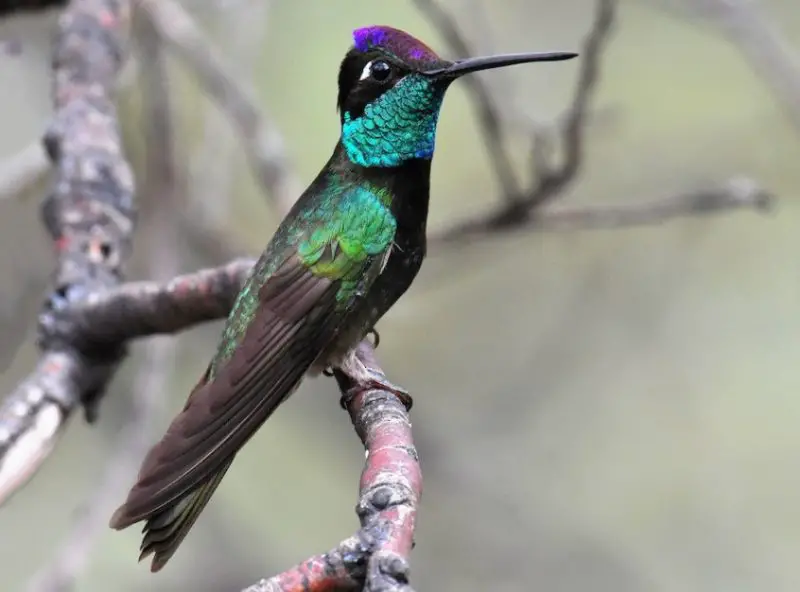
The Magnificent Hummingbird, also known as the Rivoli’s Hummingbird, is a rare western vagrant that occasionally reaches Alabama. It is one of the largest hummingbirds in North America, measuring up to 5.5 inches in length, with a long, straight bill and a powerful flight. Males are breathtaking in appearance, featuring a metallic green body, turquoise throat, and a deep violet crown that gleams in sunlight. Females are less iridescent but share the same stately proportions and dark green plumage.
This species typically inhabits high-elevation pine-oak forests in Mexico and the southwestern U.S., but rare individuals occasionally appear eastward during migration or after storms. In Alabama, sightings are exceedingly uncommon but have been recorded at feeders in southern regions during winter months. Their larger size and slow, deliberate flight make them easy to distinguish from smaller hummingbirds.
The Magnificent Hummingbird’s behavior is calm and confident; unlike the aggressive Rufous, it often tolerates the presence of other hummingbirds. It feeds on nectar from large, tubular flowers and supplements its diet with insects caught midair. Its wings produce a low, deep hum that reflects its more powerful build.
Each Alabama record of this species is notable, representing an extraordinary range extension. Ornithologists and birders alike monitor such sightings closely, as they offer insight into how weather shifts and habitat changes influence vagrant hummingbird movements across the southeastern United States.
Lucifer Hummingbird (Calothorax lucifer)
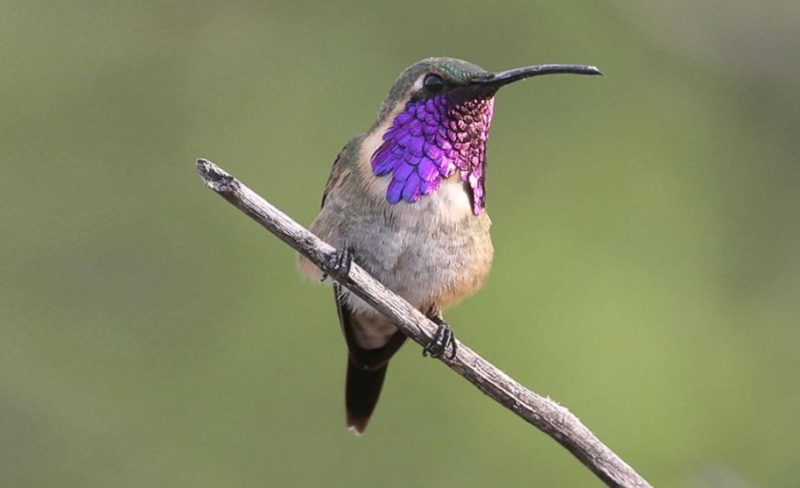
The Lucifer Hummingbird is one of the rarest and most exotic hummingbirds ever recorded in Alabama. Males are instantly recognizable by their long, decurved bills and glittering purple throats that contrast with olive-green backs and grayish underparts. Their tails are deeply forked and dark, adding to their distinctive silhouette. Females lack the purple coloring but share the graceful curved bill and slender shape.
This small species measures about 3.5 inches long and weighs around 3 grams. It feeds primarily on nectar from long, tubular flowers, often preferring desert blooms such as agave and ocotillo in its native range. Its bill shape allows it to reach nectar inaccessible to other hummingbirds, giving it a unique ecological niche.
In Alabama, the Lucifer Hummingbird has been observed only a handful of times, generally during the cooler months. Most sightings occur in southern counties where mild winters and abundant feeders provide refuge for wayward individuals. These rare appearances often spark excitement in the birding community and are well-documented through photographs and banding programs.
The presence of this desert species in Alabama highlights the unpredictability of hummingbird migration. Whether displaced by weather or exploring new feeding territories, each Lucifer Hummingbird sighting adds to the remarkable diversity of hummingbird visitors recorded in the state.
Tips to Attract and Observe Hummingbirds in Alabama
Choose the Right Feeders and Placement
To attract hummingbirds in Alabama, use feeders designed with red accents since the color naturally draws their attention. Opt for glass or sturdy plastic feeders with easy-to-clean bases to prevent mold growth. Hang your feeders in shaded or partially sunny areas to keep the nectar cool and fresh longer, ideally near flowering plants. Placing multiple feeders around your yard helps minimize territorial conflicts, allowing more birds to feed peacefully.
Keep feeders about 5 feet above the ground and away from windows or high-traffic areas. This provides the birds with a sense of security while allowing you to observe them closely. If possible, position feeders near shrubs or trees, which offer safe perching spots for resting or escaping predators.
Regular maintenance is key—clean feeders every 3 to 5 days in warm weather using hot water and a bottle brush. Replace nectar immediately if it becomes cloudy or develops black mold. Consistency and cleanliness ensure that hummingbirds return year after year.
Use Natural Nectar and Native Flowers
A homemade nectar solution of four parts water to one part white sugar is perfect for hummingbirds. Avoid using honey, brown sugar, or artificial dyes, as these can harm the birds or promote dangerous mold growth. Boil the mixture briefly, let it cool, and store it in the refrigerator for up to a week.
Enhance your yard by planting native nectar-rich flowers that bloom across different seasons. In Alabama, species like coral honeysuckle, bee balm, trumpet creeper, cardinal flower, and salvia provide ideal food sources. A layered garden design—with flowers at various heights—creates a natural feeding environment that encourages longer visits.
Mixing natural nectar sources with feeders helps hummingbirds meet their dietary needs for both energy and protein. This approach also supports local pollination, making your yard a thriving microhabitat for other pollinators.
Provide Shelter and Fresh Water
Hummingbirds require shelter for resting and protection, especially during migration or cooler months. Planting shrubs, vines, or small trees near feeding areas gives them safe perches and nesting sites. Species like wax myrtle, yaupon holly, and native azaleas provide excellent cover and visual appeal.
In addition to shelter, hummingbirds enjoy shallow water sources. A misting fountain, dripper, or gently flowing birdbath can attract them for drinking and bathing. They are particularly fond of fine mist sprays that help clean their feathers.
Keeping your backyard quiet and free from chemical pesticides encourages hummingbirds to return regularly. Creating a peaceful, flower-rich environment transforms your space into a sanctuary for these delicate yet energetic birds.
Maintain Feeders Year-Round
While Ruby-throated Hummingbirds dominate Alabama’s summer skies, several rare western species visit during the winter. Keeping at least one feeder filled year-round ensures that wandering individuals—such as Rufous, Buff-bellied, or Anna’s Hummingbirds—have a reliable food source.
During colder months, place feeders in sheltered spots to prevent nectar from freezing. You can use inexpensive outdoor heat lamps or wrap feeders with insulating materials if temperatures drop significantly. Documenting winter hummingbirds through photos or local birding apps also helps ornithologists track seasonal patterns in the region.
Feeding hummingbirds throughout the year not only benefits them but also provides birdwatchers with extraordinary viewing opportunities during Alabama’s mild winters.
FAQs about Hummingbirds in Alabama
How many hummingbird species can be seen in Alabama?
Alabama hosts one common breeding species—the Ruby-throated Hummingbird—and up to eleven rare or occasional visitors. These include Rufous, Anna’s, Black-chinned, Buff-bellied, and Broad-billed Hummingbirds, among others. Most sightings of western species occur in southern Alabama during winter.
When is the best time to see hummingbirds in Alabama?
The peak season for hummingbird activity is from late March through early October. Ruby-throated Hummingbirds arrive in spring to breed, while rare species such as Rufous or Buff-bellied appear in the colder months. Along the Gulf Coast, some hummingbirds remain through the winter.
What should I put in a hummingbird feeder?
Use a simple nectar mixture of one part white sugar to four parts water. Do not use honey, artificial sweeteners, or red food coloring. Clean and refill feeders regularly to prevent fermentation or mold, especially in Alabama’s warm climate.
Can hummingbirds survive Alabama’s winter?
Yes, several western hummingbird species have successfully overwintered in Alabama, particularly in coastal areas. These include Rufous, Buff-bellied, and Anna’s Hummingbirds. Providing clean feeders and nectar through winter can help sustain these hardy visitors.
Why are hummingbirds aggressive around feeders?
Hummingbirds are naturally territorial, especially during migration and breeding seasons. Dominant individuals defend feeders or favorite flowers by chasing others away. Installing multiple feeders spaced apart can reduce conflicts and attract more birds to your yard.
What flowers attract hummingbirds in Alabama?
Native plants like coral honeysuckle, trumpet creeper, bee balm, salvia, and cardinal flower are top choices. These species offer tubular blooms rich in nectar and are well-suited to Alabama’s climate. Planting them ensures a continuous food source throughout the year.

